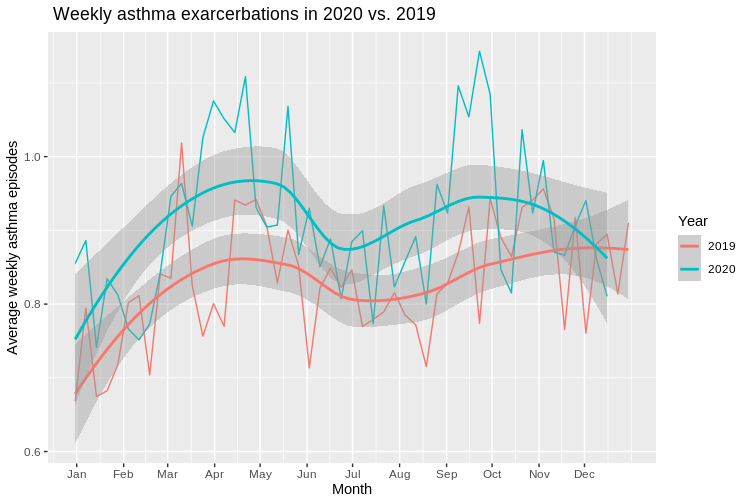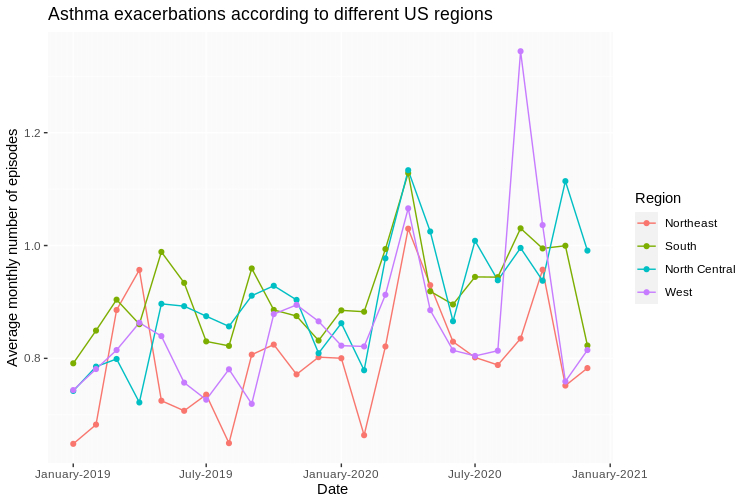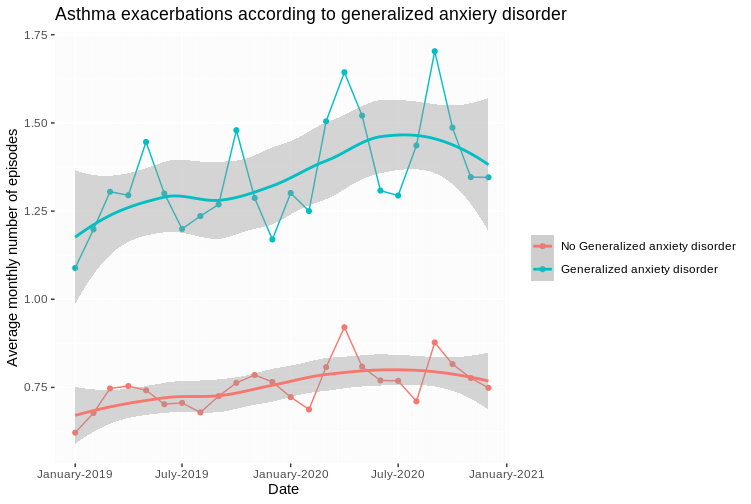By Christophe Tchakouté, 23andMe Biostatistician
The number of weekly asthma attacks among people in the U.S. with active asthma increased by 10 percent in 2020 compared to the year before, according to new research data from 23andMe.
Our scientists wanted to explore why, and better understand whether these increases in asthma attacks, known as asthma exacerbations, were influenced by geography, mental health variables, or some other factors like the unprecedented number of wildfires in the western U.S. in 2020.
Asthma, which impacts more than 25 million Americans and about 330 million people worldwide, is a chronic disease of the lungs that causes inflammation and narrowing of air pathways. Asthma attacks lead to shortness of breath, coughing, wheezing, and chest tightening. These attacks can be triggered by environmental factors, such as pollution, or smoke, or stress and anxiety. The most severe attacks can lead to hospitalization. Asthma is also an underlying risk factor for more severe symptoms from COVID-19.
Last year offered the worst combination of factors that could trigger attacks among those with asthma, including massive wildfires on the West Coast, as well as economic uncertainty and stress from the COVID-19 pandemic. But understanding what contributed to last year’s increase in asthma attacks is not so simple. For one, collecting longitudinal data on asthma is challenging and there is a scarcity of data looking at asthma attacks in 2020.

Figure 1: Year-over-year comparison of asthma attacks.
In looking at 23andMe research data, collected from customers in the United States with asthma who consented to participate in research, even after controlling for known exacerbation risk factors such as obesity, area of residence, and sex (women are at higher risk for asthma), our researchers still saw a year over year increase in asthma attacks. (see Figure 1).
The increase also surprised our researchers, who anticipated that the shelter-in-place orders enacted in March 2020 would decrease pollution and subsequently result in a decrease in asthma exacerbations. However, this explanation is unlikely since springtime asthma exacerbations were higher in 2020 compared to 2019 and followed similar seasonal trends as in 2019 due to allergies (see Figure 1). Such seasonal fluctuations occur because the increase of pollen due to changes in the weather can trigger asthma symptoms.

Figure 2: Asthma exacerbations across different US regions
23andMe researchers’ analysis also compared monthly asthma exacerbations from 2019 to 2020 across the four main regions of the United States: the South, the West, the Northeast, and North Central. They did not observe substantial differences in monthly asthma exacerbations across regions for 2019 and early 2020 (See Figure 2).
However, from the end of the summer of 2020 to the beginning of the fall of 2020, researchers observed a steep increase in asthma exacerbations on the West Coast (See Figure 2). This timeline overlaps with the western wildfires that resulted in severe air pollution over multiple weeks on the West Coast. According to one estimate by Cal Fire, the 2020 California wildfires pumped a record of more than 115 million metric tons of CO2 into the air, or more than eight times the annual average.
Initially, 23andMe was also interested in exploring how anxiety changed monthly from 2019 to 2020. However, none of the anxiety-related longitudinal surveys in the 23andMe research data could be used to address this specific question. Instead, researchers compared monthly self-reported asthma exacerbations from 2019 to 2020 among research participants with active asthma and generalized anxiety disorder and those with active asthma and no generalized anxiety disorder (see figure 3). The team found that asthma exacerbations increased from 2019 to 2020 in both groups. On average, customers with a generalized anxiety disorder had 62 percent higher levels of asthma exacerbations when compared with those with no generalized anxiety disorder (see figure 3) after adjusting for other important variables.

Figure 3: Asthma exacerbations and generalized anxiety disorder
This small sample analysis highlighted an increase in asthma exacerbations in 2020. Although it was not possible to track how anxiety changed from 2019 to 2020, this analysis demonstrated that research participants with a generalized anxiety disorder had high levels of asthma exacerbations in 2020.
In addition, a strong association between the western wildfires and a spike in asthma exacerbations was observed in 23andMe research data. This is consistent with previous evidence shedding light on the link between proximity to wildfires and chronic lung disease exacerbation.
Given that asthma exacerbation can lead to severe hospitalizations as well as worsen COVID-19 disease prognosis, special consideration should be given to this population.
This small analysis highlights how 23andMe research data can be leveraged to gain rapid insights into how naturally occurring events can affect the health of a specific subpopulation.
23andMe Customers who have consented to participate in research and who wish to contribute to our asthma survey can do so here. Not yet a customer? Find out more about our service here or you can learn about some of our published research here.



